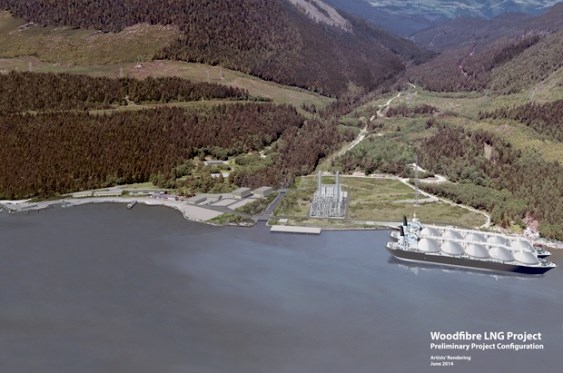The provincial government has given the proposed Woodfibre liquefied natural gas export facility in Howe Sound environmental approval, despite concerns expressed by local municipalities and environmental groups opposed to the project.
On Monday, B.C. Environment Minister Mary Polak and Natural Gas Development Minister Rich Coleman issued the project an environmental assessment certificate, subject to 25 conditions.
The provincial decision comes after the Squamish Nation council recently gave the project its own conditional green light in a 12-2 vote, following a separate environmental assessment.
Byng Giraud, vice-president of corporate affairs for Woodfibre LNG, described the province’s environmental approval as “a significant milestone, but one of many.”
In particular, Woodfibre still needs approval from the new federal government before it can go ahead with what Giraud described as a “final investment decision.”
“Obviously we’re watching closely to see what the federal government’s going to do,” said Giraud. “We still need the federal approvals.”
Both prime minister-designate Justin Trudeau and new Liberal MP for West Vancouver-Sunshine Coast- Sea to Sky Country, Pam Goldsmith-Jones, were noncommittal about the Woodfibre project when asked about it during the election campaign.
Woodfibre Natural Gas Ltd. – owned by Pacific Oil and Gas – wants to liquefy and export 2.1-million tonnes of LNG per year at a plant built on the site of a former pulp mill near Squamish. If approved, the $1.6-billion facility would ship 40 double-hulled LNG tankers to Asia each year.
For the past two years, the proposed project has pit residents throughout the Howe Sound corridor who question possible environmental impacts and safety risks against others who see the project providing jobs and a needed economic boost.
West Vancouver council was one of several local municipalities that voted last summer to request a ban on LNG tanker traffic in Howe Sound.
Opponents of the project who turned out to a meeting in West Vancouver earlier this year raised concerns ranging from the risk of shipping accidents in Howe Sound, possible environmental impacts of the plant’s proposed seawater cooling system, large wakes from the tankers and potential air pollution.
In written reasons for the decision, the provincial ministers stated conditions placed on the project will prevent or reduce any serious problems.
Among issues pointed to, the ministers pointed to the depth of the seawater cooling marine intake as minimizing impacts on juvenile herring – one of the environmental concerns identified.
They also noted the company has agreed to slow the speed of the LNG tankers to minimize the wake from the tankers and reduce impacts on marine mammals. They added each tanker would be accompanied by at least three escort tugs and be guided by two coast pilots.
An analysis of safety risks and emergency response will have to be completed as part of the permit application to the B.C. Oil and Gas Commission, the ministers noted.
Ruth Simons, executive director of the Future of Howe Sound Society, said she was disappointed but not surprised that the project had been granted environmental approvals. Simons said approval of the project was “pre-determined” by the provincial government, but noted many communities around Howe Sound remain opposed to it. “This project didn’t obtain a social licence to proceed,” she said.
Delena Angrignon, co-founder of the My Sea to Sky group, called the provincial approval “reckless” and the process used to assess the project inadequate.
Angrignon pointed to potential impacts of the seawater cooling system as among issues that haven’t been addressed.
“If this is supposed to be such a rigorous process why are they being given an environmental assessment certificate knowing this system has been banned (in California)?” she said.
She said her group is calling on the new federal government to put a moratorium on LNG exports.
During a campaign stop in West Vancouver this summer to promote marine environmental policies, Trudeau side-stepped the issue of whether a Liberal government would support the Woodfibre LNG plan, saying only that “citizens need to be assured issues are properly addressed.”
On the campaign trail, Goldsmith-Jones called for “an immediate audit of the environmental legislation that’s been gutted over the course of a decade before we can entertain any proposal.”
At that time, Goldsmith-Jones also criticized marine safety standards that would govern tanker traffic in Howe Sound as “inadequate” but did not come out as either for or against the project.
She could not be reached for comment by press time.
Giraud said the company is hoping final approvals will be granted in 2016, which would mean the plant could be operating by 2018.
In addition to regulatory approvals, “we still have to ensure we have markets for our gas,” he said, adding that the company is taking part in an upcoming trade mission to China with B.C. Premier Christy Clark.
The company that owns Woodfibre also owns 35 per cent of a state-owned LNG import facility in China.



